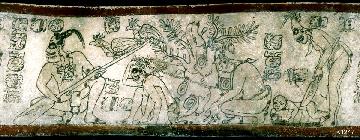 |
Charles Zidar
ANCIENT MAYA BOTANICAL RESEARCH |
|
| Family: | Sapotaceae | | Genus: | Manilkara | | Species: | zapota | | Authority: | (L.) P. Royen | | Common Name: | sapodilla | | Maya Name: | Ya’, yaa, chicle, chicle tree, chico, zapote, red sapodilla, sapadilla, sapote, zapote, zapotillo, zapote blanco, zapote colorado and zapote morado | | Maya Plant Use: | Food, gum, medicine, latex, construction
The dense wood was used as carved lintels in the doorways of many Maya temples some of which still exist today. Recently the sap was used as the main ingredient in chewing gum and can be used as a salve for burns and other wounds. The fruit is an ingredient in sweets and ice cream. A tea from the berries can also rid the stomach of parasites. (Schlesinger, 2001). Pouteria sapota and Pouteria viride are related plants.
| | Botanical Significance: | Given its strength and durability, sapodilla was used for lintels, some of which still exist today. | | Ritual Significance: | The sap was also sacred to the Maya and was one of the itz, a medium in which spirits manifested themselves.
Given the usefulness of this plant in ancient times, it is not surprising to find it represented in Maya art and iconography. For its sap to be considered an itz and for its wood to be used in the most important of buildings, the plant had to have been held in high regard by the ancient Maya and its elite. | | Notes: | Syn: Achras zapota L., M. achras (Mill.) Fosberg, M. breviloba Gilly | | Photos: | Click on an image below for high resolution comparison. |
| |


